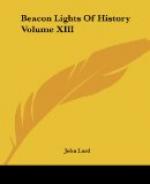“FAUST.”
Goethe appears to have derived his knowledge of the Faust legend partly from the work of Widmann, published in 1599,[10] partly from another more modern in its form, which appeared in 1728, and partly from the puppet plays exhibited in Frankfort and other cities of Germany, of which that legend was then a favorite theme. He was not the only writer of that day who made use of it. Some thirty of his contemporaries had produced their “Fausts” during the interval which elapsed between the inception and publication of his great work. Oblivion overtook them all, with the exception of Lessing’s, of which a few fragments are left; the manuscript of the complete work was unaccountably lost on its way to the publisher, between Dresden and Leipsic.
[Footnote 10: The earlier work of Spiess (1588) was translated into English and furnished Marlowe with the subject-matter of his “Dr. Faustus.”]
The composition of “Faust,” as we learn from Goethe’s biography, proceeded spasmodically, with many and long interruptions between the inception and conclusion. Projected in 1769 at the age of twenty, it was not completed till the year 1831, at the age of eighty-two....
But the effect of the long arrest, which after Goethe’s removal to Weimar delayed the completion of the “Faust,” is most apparent in the wide gulf which separates, as to character and style, the Second Part from the First. So great, indeed, is the distance between the two that, without external historical proofs of identity, it would seem from internal evidence altogether improbable, in spite of the slender thread of the fable which connects them, that both poems were the work of one and the same author. And really the author was not the same. The change which had come over Goethe on his return from Italy had gone down to the very springs of his intellectual life.




